Oh, to Be a Tree!
It was my first visit to the ARC’s Festival of Trees—an annual fundraiser for the organization that supports people with intellectual and developmental disabilities. There were lighted trees everywhere—about 50 of them—each with a different theme and gloriously decorated.
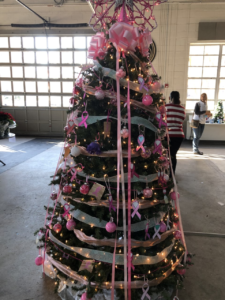
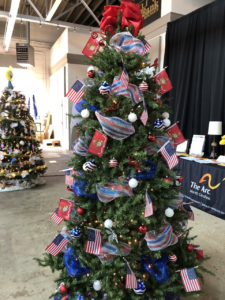
There were three, though, that were particularly engaging–the bright pink one for breast cancer awareness, the patriotic one honoring the military, and the purple one promoting Alzheimer’s awareness.
To me, it was the third tree that was most touching. It had been decorated by residents and staff at Trinity Living Center and bore a sign 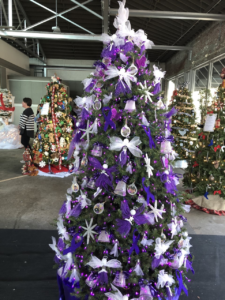 that read, “To love a person is to learn the song in their heart and sing it to them when they have forgotten.” Having lost my mother-in-law to the disease and seen the devastation it has caused in other families, I walked away with tears in my eyes.
that read, “To love a person is to learn the song in their heart and sing it to them when they have forgotten.” Having lost my mother-in-law to the disease and seen the devastation it has caused in other families, I walked away with tears in my eyes.
As I headed to my car to resume my Saturday morning activities, I determined to do a little research on the tradition of Christmas trees. A perusal of the Internet proved very interesting.
It seems that for thousands of years pagans used evergreens to decorate their homes as part of their celebrations of the winter solstice and the promise of spring. Some even made idols of their trees.
Jeremiah warned the children of Israel about such practices:
“Do not learn the ways of the nations
or be terrified by signs in the heavens,
though the nations are terrified by them.
For the practices of the peoples are worthless;
they cut a tree out of the forest,
and a craftsman shapes it with his chisel.
They adorn it with silver and gold;
they fasten it with hammer and nails
so it will not totter.
Like a scarecrow in a cucumber field,
their idols cannot speak;
they must be carried
because they cannot walk.
Do not fear them;
they can do no harm
nor can they do any good.” (Jeremiah 10:2-5 NIV)
Pretty sobering, isn’t it? Yet through time, the practice crept into Christian celebrations. Almost everyone I know puts up a Christmas tree, myself included. Hopefully, we don’t worship them, but we do spend much time and money getting just the right one and decorating it to our satisfaction.
The Germans are credited with first displaying Christmas trees as we do today. In the 16th century, devout Christians began bringing trees into their homes and adorning them with apples, white candy canes and pastries in the shapes of stars, hearts and flowers at Christmas time. Evergreens were chosen as a representation of eternal life. Glass beads, garlands, and tin ornaments were first made by Hans Greiner (1550–1609), in Lauscha, Germany, to further beautify the trees.
According to tradition, Martin Luther, the 16th-century Protestant reformer, was the first to add lighted candles to a tree. Walking toward his home one winter evening, planning a sermon as he walked, he was awestruck by the brilliance of stars twinkling through the evergreens. To share the scene with his family, he erected a tree in the main room and wired its branches with lighted candles.
When German families began to migrate to Pennsylvania in the late 1700’s and early 1800’s, they brought their Christmas tree practices with them. It took time, though, for the tradition to take hold. In fact, it was not until 1800 when England’s German-born Queen Charlotte set up a decorated Christmas tree in the palace that the custom began to spread to other English-speaking countries.
Christmas trees aside, the Bible has almost 300 references to trees in general. Trees apparently bring the Lord much pleasure for they are mentioned in both the first (Genesis 1:11) and last (Revelation 22:2, 14, 19) chapters of the Scriptures. Also, they are frequently used as metaphors, analogies, and similes when speaking of spiritual matters.
Three of my favorite passages in all the Scriptures talk about trees.
First, in Psalm 52:8, David wrote:
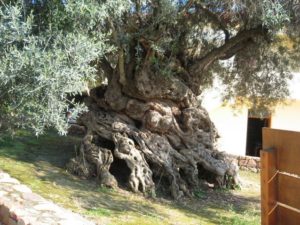 “But I am like an olive tree, thriving in the house of God. I will always trust in God’s unfailing love.”
“But I am like an olive tree, thriving in the house of God. I will always trust in God’s unfailing love.”
And why would he compare himself to an olive tree? I think it is because they are extremely hardy evergreens that can live for hundreds of years faithfully producing olives. Their extensive root systems make them drought, disease, and fire resistant. There are olive trees on the island of Crete, like the picture above, that are believed to be 2000 to 3000 years old and are still producing olives!
Now, that’s what I want to be!
Second, Isaiah wrote that we are to be like “oak trees.” He prophesied that Jesus would come to bind up the brokenhearted, comfort those who mourn, and transform believers into “oaks of righteousness.” He states:
“The Spirit of the Sovereign Lord is on me,
because the Lord has anointed me
to proclaim good news to the poor.
He has sent me to bind up the brokenhearted . . .
to bestow on them a crown of beauty
instead of ashes,
the oil of joy
instead of mourning,
and a garment of praise
instead of a spirit of despair.
They will be called oaks of righteousness,
a planting of the Lord
for the display of his splendor.”
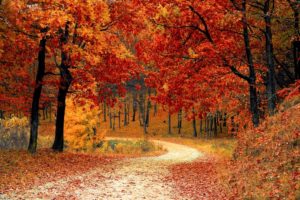 The redeemed, then, are to become “oaks of righteousness.”
The redeemed, then, are to become “oaks of righteousness.”
Think about it. Oak trees are beautiful, strong, magnificent, long-lived, with massive roots that keep them grounded when the storms come. That’s what we’re to be—not easily blown about by the storms of life.
Oh, to be a mighty “oak” displaying the splendor of the Lord! What a calling!
Third, Jeremiah explains that believers are to be “like trees planted by a riverbank.”
 “But blessed are those who trust in the Lord and have made the Lord their hope and confidence. They are like trees planted along a riverbank, with roots that reach deep into the water. Such trees are not bothered by the heat or worried by long months of drought. Their leaves stay green, and they never stop producing fruit. Their leaves never wither, and they prosper in all they do.” (Jeremiah 17:7-8)
“But blessed are those who trust in the Lord and have made the Lord their hope and confidence. They are like trees planted along a riverbank, with roots that reach deep into the water. Such trees are not bothered by the heat or worried by long months of drought. Their leaves stay green, and they never stop producing fruit. Their leaves never wither, and they prosper in all they do.” (Jeremiah 17:7-8)
Wow! If we place our trust in Him and drink from his Living Water, we will remain strong and productive in this life and finally move to heaven where we will eat of the tree of life!
“Then the angel showed me the river of the water of life, as clear as crystal, flowing from the throne of God and of the Lamb down the middle of the great street of the city. On each side of the river stood the tree of life, bearing twelve crops of fruit, yielding its fruit every month. And the leaves of the tree are for the healing of the nations.” (Revelation 22:1-2 NIV)
Hallelujah! What a blessing! What an awesome Lord and Savior we serve!
Challenge: What about you? Ever thought of yourself as an “olive tree thriving in the house of the Lord” or an “oak of righteousness” or a “tree planted along a riverbank” drawing from the “Living Water?”
Perhaps during this Christmas season, we should spend some time thinking about “being trees” rather than just decorating and admiring them? As Jeremiah said “they (decorated trees) can do no harm nor can they do any good.” (Jeremiah 10:5 NIV) But we, as Christians, can do some good. We can be true lights in the darkness. In fact, Jesus commands,
“In the same way, let your light shine before others, that they may see your good deeds and glorify your Father in heaven.” (Matthew 5:16 NIV)
Our mission during the Christmas season and all year long? To shine, Sister Olive and Brother Oak, shine!
4 thoughts on “Oh, to Be a Tree!”
Thank you so much for this!! My faith in my Lord Father is so strong and grows everyday. He blesses me in so many ways. I am trying, inadvertently actually, trying to be a tree of brightness for some. God is showing me things about myself I never knew. I am trying to comfort some during trying times, and also trying to spread my knowledge and teach a few. What s lovely place for me to be at this time in my life! God bless you Shirley. You know I love you.
Thank you, Barbara. I am very proud of you! To see the mighty work the Lord is doing in your life is a wonderful blessing! I love you, too, my sister!
Thank you Shirley for the history lesson. I’ve often said I have never met a tree I didn’t love; Fall, winter, and Spring they take on different appearances and are beautiful in every stage.
Thank you, Brenda! I love trees, too. The Lord has truly blessed us with the beauty of nature. Many blessings.
Comments are closed.